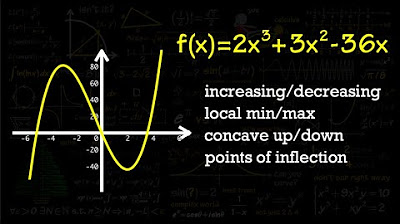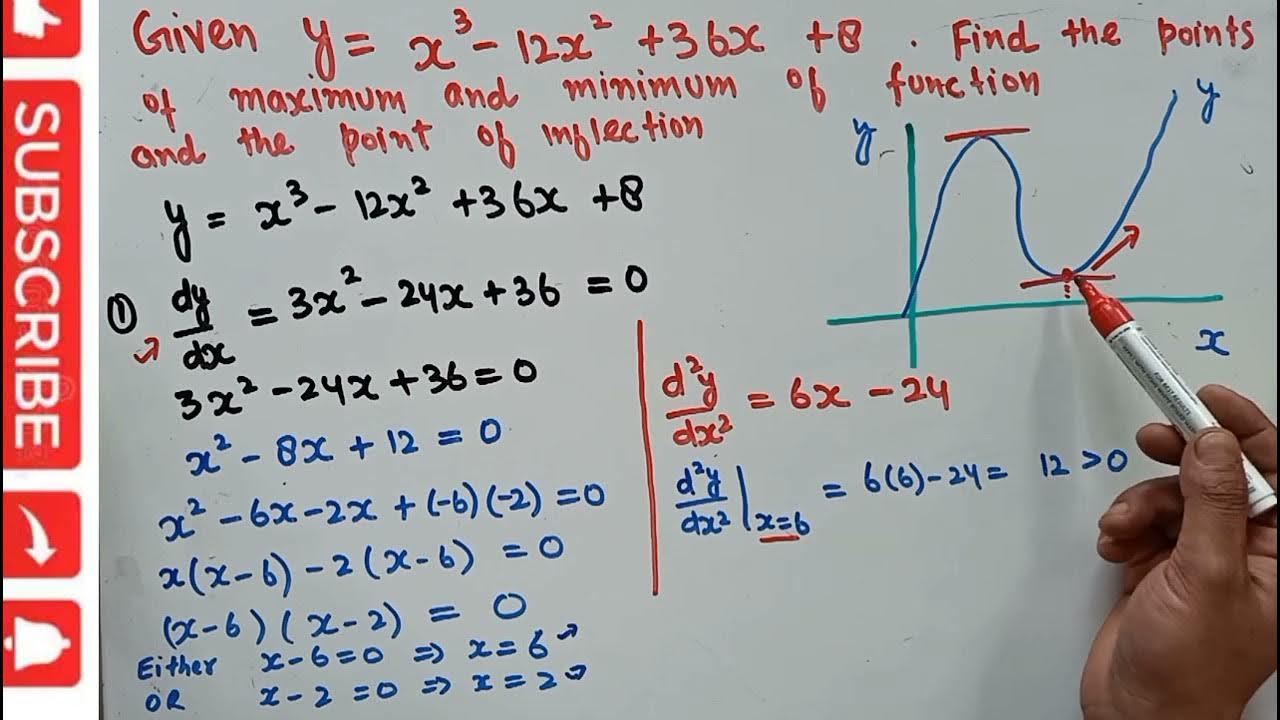Absolute Maximum and Minimum Values - Finding absolute MAX & MIN of Functions - Calculus
TLDRThis educational video script outlines the process of finding the absolute maximum and minimum values of a function on a closed interval. It begins with an example function f(x) = x^4 - 2x^3 and interval [-2, 2], demonstrating how to find critical points by setting the derivative f'(x) = 4x^3 - 6x^2 to zero. The critical points are x = 0 and x = 3/2, where the function is evaluated along with the endpoints. The script then compares these values to determine the absolute maximum (32) and minimum (-27/16). The process is reiterated with a second example, f(x) = 2x^3 - 6x - 1, interval [-3, 2], with critical points x = -1 and x = 1, leading to the identification of the absolute minimum (-37) and maximum (3). The script effectively teaches the steps involved in finding extrema for continuous functions on closed intervals.
Takeaways
- 📍 To find the absolute maximum and minimum values of a function within an interval, you need to identify critical points and evaluate the function at these points and the interval's endpoints.
- 🔍 Critical points are determined by setting the derivative of the function equal to zero and also considering points where the derivative does not exist.
- 🎯 For the function f(x) = x^4 - 2x^3, the critical points are found by setting the derivative f'(x) = 4x^3 - 6x^2 = 0, which simplifies to 2x^2 - 3 = 0, resulting in x = 0 and x = 3/2.
- 📈 Evaluate the function at the critical points and the interval's endpoints to find the values of the function. For the given function, F(0) = 0, F(3/2) = -27/16, and F(-2) = 32, F(2) = 0.
- 🔎 Compare the values to identify the absolute maximum and minimum. In this case, the maximum value is 32, and the minimum value is -27/16.
- 📝 For another function, f(x) = 2x^3 - 6x - 1, critical points are found by setting f'(x) = 6x^2 - 6 = 0, which simplifies to x^2 - 1 = 0, resulting in x = 1 and x = -1.
- 🔍 Evaluate the function at the critical points and the interval's endpoints. For the function f(x) = 2x^3 - 6x - 1, F(-3) = -54, F(-1) = 3, F(1) = -5, and F(2) = 3.
- 📊 By comparing the values, the absolute minimum is -54, and the absolute maximum is 3.
- 🔑 Remember, the process involves finding critical points, evaluating the function at these points and the endpoints, and comparing the values to find the absolute maximum and minimum.
- 📈 For a function with a closed form, such as f(x) = x^4 - 2x^3, the process is straightforward as the critical points and endpoints are easily identified and evaluated.
- 🔎 For functions with more complex forms, such as f(x) = 2x^3 - 6x - 1, the process becomes more involved, requiring careful algebraic manipulation to find critical points and evaluate the function accurately.
- 📝 It's important to practice with different functions and intervals to become proficient in finding absolute maximum and minimum values.
Q & A
What is the main topic of the video?
-The main topic of the video is to demonstrate how to find the absolute maximum and minimum values of a function on a given interval.
What is the first step in finding absolute maximum and minimum values of a function?
-The first step is to find the critical points of the function, which are potential candidates for absolute maximum and minimum values.
How are critical points determined for a function?
-Critical points are determined by finding the derivative of the function (f'(x)) and setting it equal to zero, as well as identifying points where the derivative does not exist.
What is the function given in the first example of the video?
-The function given in the first example is f(x) = x^4 - 2x^3, with the interval from -2 to 2.
How many critical points does the first example function have?
-The first example function has two critical points: x = 0 and x = 3/2.
What are the endpoints of the interval in the first example?
-The endpoints of the interval in the first example are -2 and 2.
What is the maximum value of the first example function on the given interval?
-The maximum value of the first example function on the interval is 32.
What is the minimum value of the first example function on the given interval?
-The minimum value of the first example function on the interval is -27/16.
What is the second function given in the video for finding absolute maximum and minimum values?
-The second function given in the video is f(x) = 2x^3 - 6x - 1, with the interval from -3 to 2.
What are the critical points of the second function in the video?
-The critical points of the second function are x = 1 and x = -1.
What are the values of the second function at its critical points and endpoints?
-The values at the critical points and endpoints are -37 at x = -3, 3 at x = -1, -5 at x = 1, and 3 at x = 2.
What are the absolute maximum and minimum values of the second function on the given interval?
-The absolute maximum value of the second function is 3, and the absolute minimum value is -37.
Outlines
📚 Finding Absolute Maximum and Minimum Values of a Function
This paragraph introduces the process of finding the absolute maximum and minimum values of a function on a given interval. The example function provided is f(x) = x^4 - 2x^3, with the interval [-2, 2]. The first step involves finding the critical points by taking the derivative, f'(x) = 4x^3 - 6x^2, and setting it to zero, which yields x = 0 and x = 3/2. The next step is to evaluate the function at the critical points and at the endpoints of the interval. By calculating f(-2), f(2), f(0), and f(3/2), the values obtained are 32, 0, 0, and -27/16, respectively. Comparing these values, it is determined that the absolute maximum value is 32 and the absolute minimum value is -27/16.
🔍 Critical Points and Function Evaluation for Absolute Extrema
The second paragraph continues the discussion on finding absolute maximum and minimum values, this time with the function f(x) = 2x^3 - 6x - 1 and the interval [-3, 2]. The process begins by finding the critical points, which are the solutions to the derivative f'(x) = 6x^2 - 6 set to zero, resulting in x = 1 and x = -1. The function is then evaluated at these critical points as well as at the interval endpoints. The values obtained are f(-3) = -37, f(-1) = 3, f(1) = -5, and f(2) = 3. By comparing these values, the absolute minimum is identified as -37 and the absolute maximum as 3.
Mindmap
Keywords
💡Absolute Maximum and Minimum
💡Function
💡Unenclosed Interval
💡Critical Points
💡Derivative
💡Factoring
💡Endpoints
💡Closed Interval
💡Continuous Function
💡Evaluation
Highlights
Introduction to finding absolute maximum and minimum values of a function on a given interval.
Example given with function f(x) = x^4 - 2x^3 and interval [-2, 2].
Explanation of critical points as candidates for absolute maximum and minimum.
Derivation of f'(x) = 4x^3 - 6x^2 to find critical points.
Factoring out 2x^2 to solve for critical points x = 0 and x = 3/2.
Evaluating the function at critical points and endpoints to find absolute values.
Calculation of f(-2), f(2), f(0), and f(3/2) to determine function values.
Identification of maximum value 32 and minimum value -27/16 for the function.
Review of the process for finding absolute maximum and minimum of a continuous function.
Second example with function f(x) = 2x^3 - 6x - 1 and interval [-3, 2].
Derivation of f'(x) = 6x^2 - 6 and solving for x to find critical points x = 1 and x = -1.
Plugging in critical points and endpoints into the function to find values.
Calculation of f(-3), f(-1), f(1), and f(2) to compare function values.
Determination of absolute minimum -37 and maximum 3 for the second function.
Summary of the importance of evaluating function values at critical points and endpoints.
Emphasis on comparing values to find the absolute maximum and minimum.
Transcripts
Browse More Related Video

Increasing/Decreasing, Concave Up/Down, Inflection Points

Analyzing a function with its derivative | AP Calculus AB | Khan Academy

Fiding Relative Max, Min and Inflection Point with Derivatives F4

Maxima , minima and point of inflection

2011 Calculus AB free response #4b | AP Calculus AB | Khan Academy

Finding Critical Values
5.0 / 5 (0 votes)
Thanks for rating: